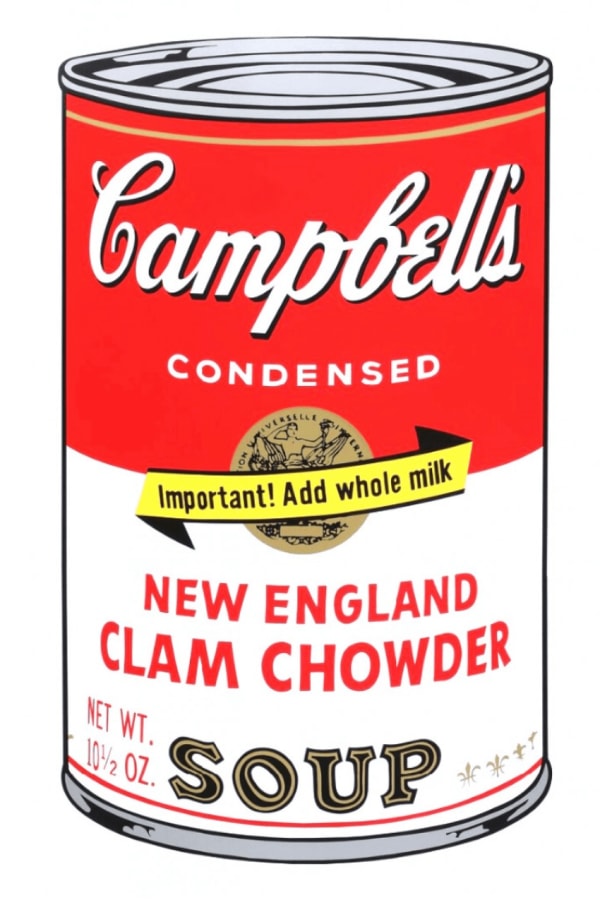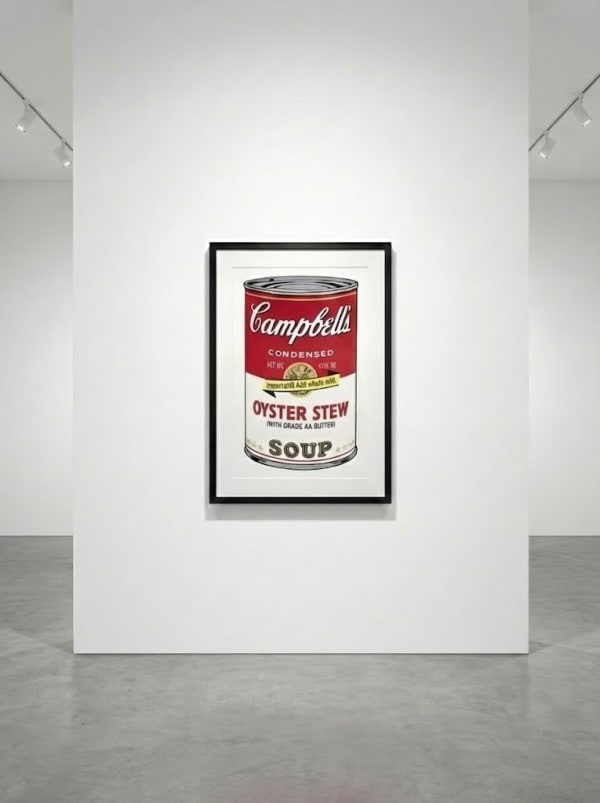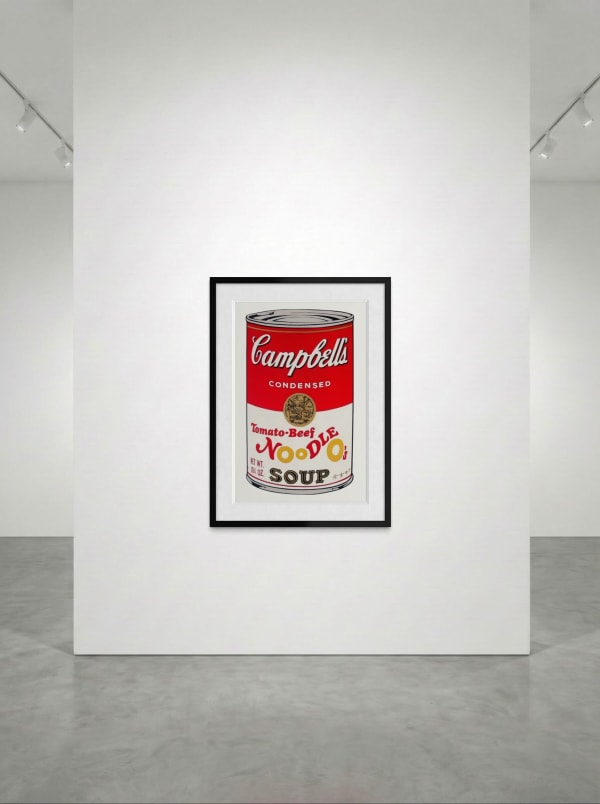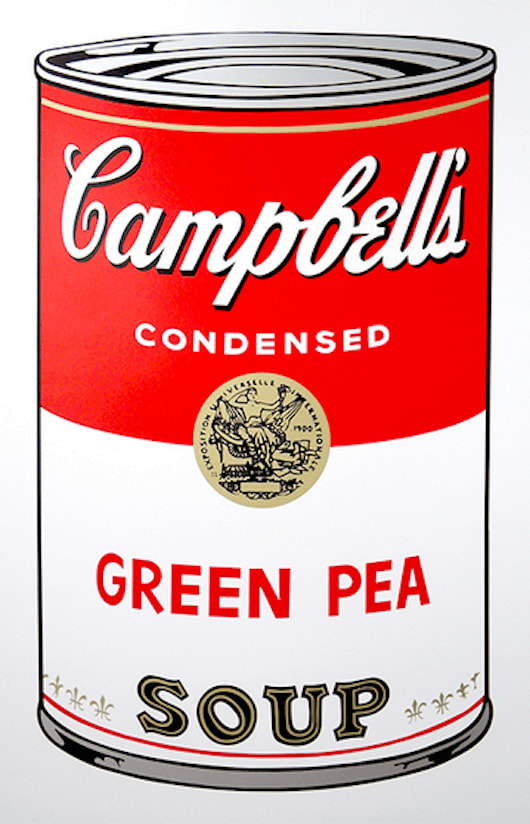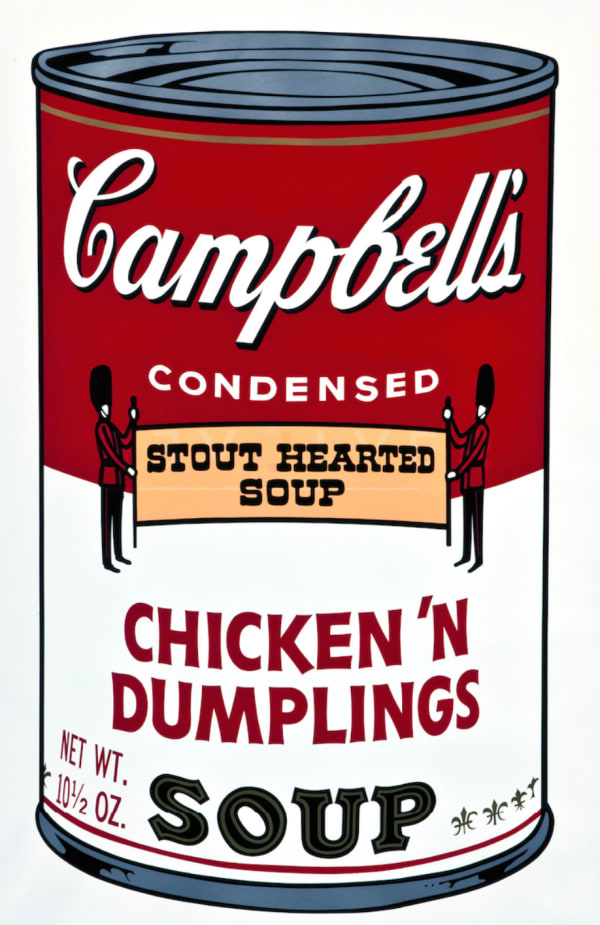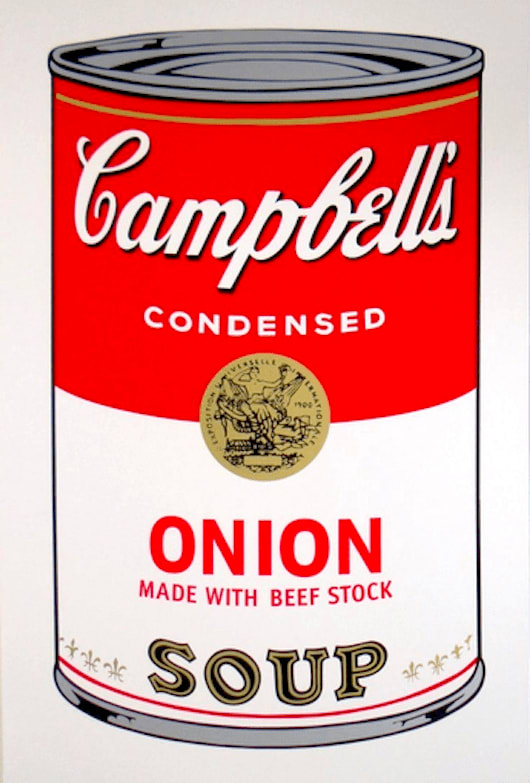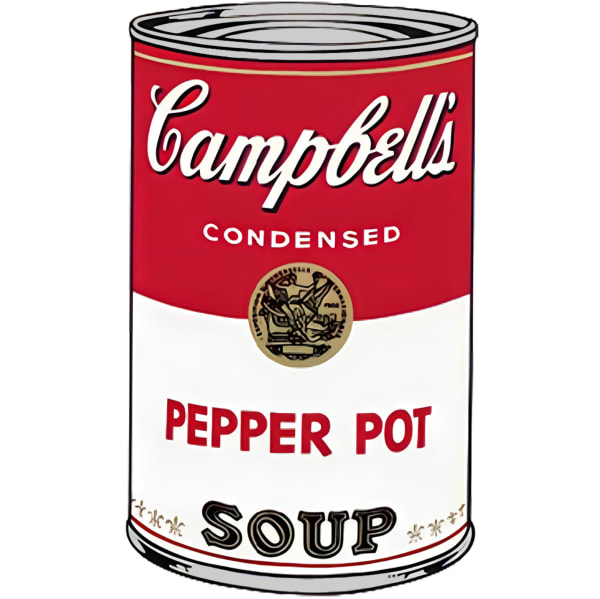
Andy Warhol
Campbell's Soup II F.S. II 54 - 63, 1969
The complete portfolio of 10 screen prints on paper
35 x 23 in (each)
88.9 x 58.4 cm (each)
88.9 x 58.4 cm (each)
Edition of 250 plus 26 AP lettered A - Z
Series: Campbell’s Soup II
Copyright The Artist
Andy Warhol's Campbell's Soup Can II series of signed screen prints from 1969 is a quintessential example of his iconic Pop art style and his fascination with mass-produced consumer goods....
Andy Warhol's Campbell's Soup Can II series of signed screen prints from 1969 is a quintessential example of his iconic Pop art style and his fascination with mass-produced consumer goods. Building upon his groundbreaking Campbell's Soup Cans series from 1962, which featured thirty-two canvases, each depicting a different flavor of Campbell's Soup, the Campbell's Soup Can II series is a refined exploration of Warhol's fascination with repetition, consumerism, and the blurring of high and low culture.
In this series, Warhol revisits the Campbell's Soup can motif, but with a subtle twist. While the 1962 series celebrated the banality of everyday objects by depicting them in a stark, repetitive manner, the 1969 series adds an additional layer of complexity through the use of color and abstraction. The cans in Campbell's Soup Can II are rendered in vibrant hues, deviating from the original red, white, and black color scheme of the 1962 series. This departure from reality adds a surreal quality to the works, inviting viewers to question the nature of representation and perception.
Each screen print in the series is meticulously crafted, showcasing Warhol's mastery of the silk-screening process. The prints are characterized by crisp lines, bold colors, and a sense of flatness that is emblematic of Warhol's aesthetic. By employing the silk-screening technique, Warhol was able to mass-produce these images, further underscoring his fascination with the commodification of art and consumer goods.
One notable aspect of the Campbell's Soup Can II series is Warhol's decision to sign each print, marking a departure from his earlier works, which often eschewed traditional notions of authorship and originality. By signing these prints, Warhol imbues them with a sense of authenticity and value, while simultaneously challenging the notion of what constitutes a unique work of art.
The Campbell's Soup Can II series is a testament to Warhol's enduring influence on contemporary art and culture. By elevating the mundane to the realm of high art, Warhol challenged conventional notions of beauty, value, and taste, paving the way for future generations of artists to explore the intersection of art and commerce. Today, these prints remain iconic symbols of Warhol's artistic vision and his ongoing exploration of the relationship between art and consumer culture.
In this series, Warhol revisits the Campbell's Soup can motif, but with a subtle twist. While the 1962 series celebrated the banality of everyday objects by depicting them in a stark, repetitive manner, the 1969 series adds an additional layer of complexity through the use of color and abstraction. The cans in Campbell's Soup Can II are rendered in vibrant hues, deviating from the original red, white, and black color scheme of the 1962 series. This departure from reality adds a surreal quality to the works, inviting viewers to question the nature of representation and perception.
Each screen print in the series is meticulously crafted, showcasing Warhol's mastery of the silk-screening process. The prints are characterized by crisp lines, bold colors, and a sense of flatness that is emblematic of Warhol's aesthetic. By employing the silk-screening technique, Warhol was able to mass-produce these images, further underscoring his fascination with the commodification of art and consumer goods.
One notable aspect of the Campbell's Soup Can II series is Warhol's decision to sign each print, marking a departure from his earlier works, which often eschewed traditional notions of authorship and originality. By signing these prints, Warhol imbues them with a sense of authenticity and value, while simultaneously challenging the notion of what constitutes a unique work of art.
The Campbell's Soup Can II series is a testament to Warhol's enduring influence on contemporary art and culture. By elevating the mundane to the realm of high art, Warhol challenged conventional notions of beauty, value, and taste, paving the way for future generations of artists to explore the intersection of art and commerce. Today, these prints remain iconic symbols of Warhol's artistic vision and his ongoing exploration of the relationship between art and consumer culture.
%3Cdiv%20class%3D%22artist%22%3EAndy%20Warhol%3C/div%3E%3Cdiv%20class%3D%22title_and_year%22%3E%3Cspan%20class%3D%22title_and_year_title%22%3ECampbell%27s%20Soup%20II%20F.S.%20II%2054%20-%2063%3C/span%3E%2C%20%3Cspan%20class%3D%22title_and_year_year%22%3E1969%20%3C/span%3E%3C/div%3E%3Cdiv%20class%3D%22medium%22%3EThe%20complete%20portfolio%20of%2010%20screen%20prints%20on%20paper%20%3C/div%3E%3Cdiv%20class%3D%22dimensions%22%3E35%20x%2023%20in%20%28each%29%20%3Cbr/%3E%0A88.9%20x%2058.4%20cm%20%28each%29%20%3C/div%3E%3Cdiv%20class%3D%22edition_details%22%3EEdition%20of%20250%20plus%2026%20AP%20lettered%20A%20-%20Z%3C/div%3E%3Cdiv%20class%3D%22series%22%3E%3Cspan%20class%3D%22artwork_caption_prefix%22%3ESeries%3A%3C/span%3E%20Campbell%E2%80%99s%20Soup%20II%3C/div%3E
Related artworks
-
 Andy WarholBeef Soup F.S. II 49 , 1968
Andy WarholBeef Soup F.S. II 49 , 1968 -
 Andy WarholBlack Bean Soup F.S. II 44, 1968
Andy WarholBlack Bean Soup F.S. II 44, 1968 -
 Andy WarholCampbell's Soup Can Tomato Soup, 1985
Andy WarholCampbell's Soup Can Tomato Soup, 1985 -
 Andy WarholCampbell's Soup I F.S. II 44 - 53 (Complete Portfolio), 1968
Andy WarholCampbell's Soup I F.S. II 44 - 53 (Complete Portfolio), 1968 -
 Andy WarholVegetarian Vegetable Soup F.S. II 56, 1969
Andy WarholVegetarian Vegetable Soup F.S. II 56, 1969 -
 Andy WarholCream of Mushroom Soup F.S. II 53, 1968
Andy WarholCream of Mushroom Soup F.S. II 53, 1968 -
 Andy WarholGolden Mushroom Soup F.S. II 62, 1969
Andy WarholGolden Mushroom Soup F.S. II 62, 1969 -
 Andy WarholNew England Clam Chowder Soup F.S. II 57, 1969
Andy WarholNew England Clam Chowder Soup F.S. II 57, 1969 -
 Andy WarholVegetable Soup F.S. II 48, 1968
Andy WarholVegetable Soup F.S. II 48, 1968 -
 Andy WarholScotch Broth Soup F.S. II 55, 1969
Andy WarholScotch Broth Soup F.S. II 55, 1969 -
 Andy WarholOyster Stew Soup F.S. II 60, 1969
Andy WarholOyster Stew Soup F.S. II 60, 1969 -
 Andy WarholOld Fashioned Vegetable Soup F.S. II 54, 1969
Andy WarholOld Fashioned Vegetable Soup F.S. II 54, 1969 -
 Andy WarholTomato Beef Noodle O's Soup, F.S. II 61, from Campbell's Soup II, 1969
Andy WarholTomato Beef Noodle O's Soup, F.S. II 61, from Campbell's Soup II, 1969 -
 Andy WarholConsommé Beef Soup F.S. II 52, from Campbell's Soup I, 1968
Andy WarholConsommé Beef Soup F.S. II 52, from Campbell's Soup I, 1968 -
 Andy WarholHot Dog Bean Soup F.S. II 59, 1969
Andy WarholHot Dog Bean Soup F.S. II 59, 1969 -
 Andy WarholGreen Pea Soup F.S. II 50, 1968
Andy WarholGreen Pea Soup F.S. II 50, 1968 -
 Andy WarholChicken N Dumplings Soup F.S. II 58, 1969
Andy WarholChicken N Dumplings Soup F.S. II 58, 1969 -
 Andy WarholOnion Soup F.S. II 47, 1968
Andy WarholOnion Soup F.S. II 47, 1968 -
 Andy WarholPepper Pot Soup F.S. II 51, 1968
Andy WarholPepper Pot Soup F.S. II 51, 1968 -
 Andy WarholTomato Soup F.S. II 46 From Soup Cans Portfolio I, 1968
Andy WarholTomato Soup F.S. II 46 From Soup Cans Portfolio I, 1968 -
 Andy WarholChicken Noodle Soup F.S. II 45, 1968
Andy WarholChicken Noodle Soup F.S. II 45, 1968 -
 Andy WarholCheddar Cheese Soup F.S. II 63, 1969
Andy WarholCheddar Cheese Soup F.S. II 63, 1969







